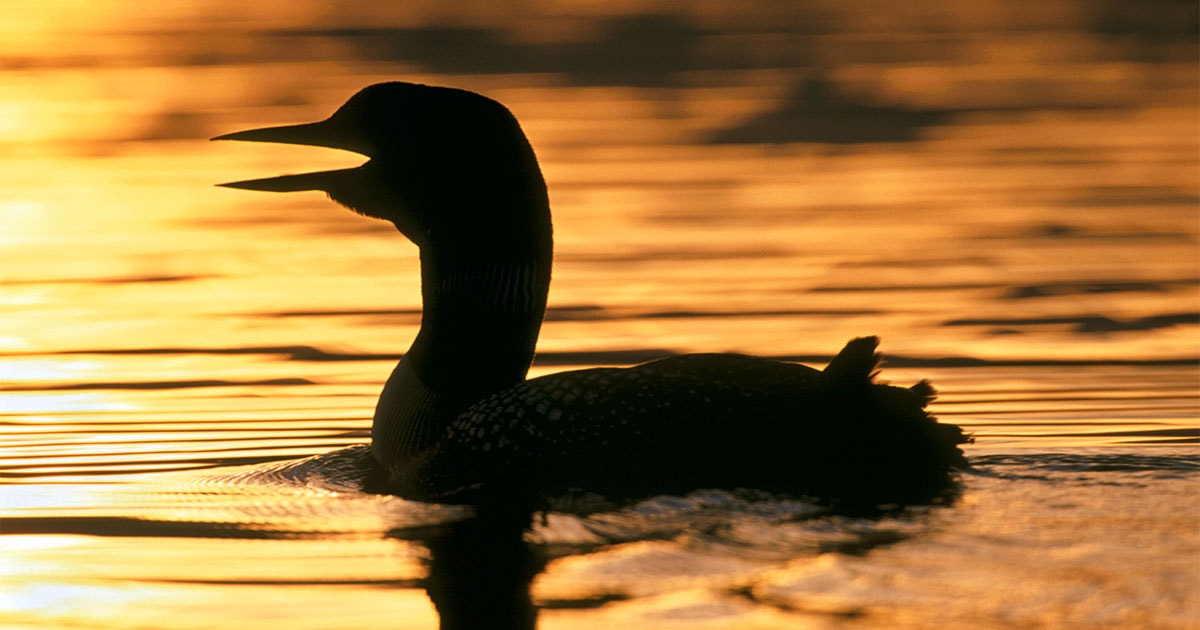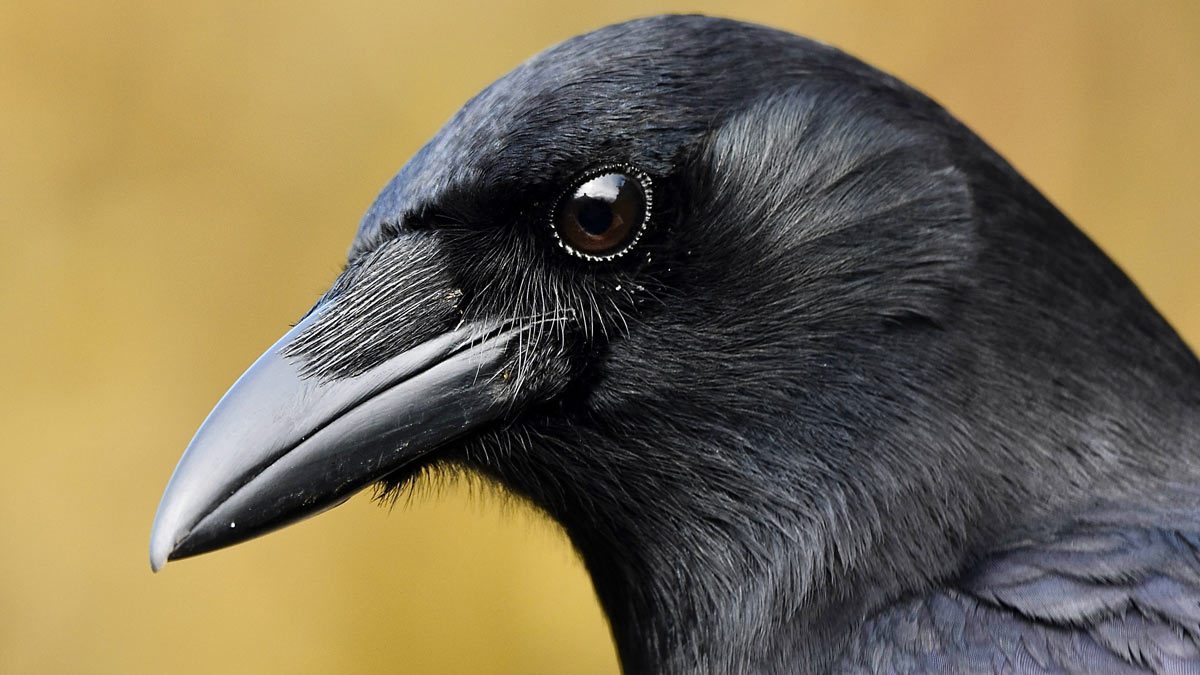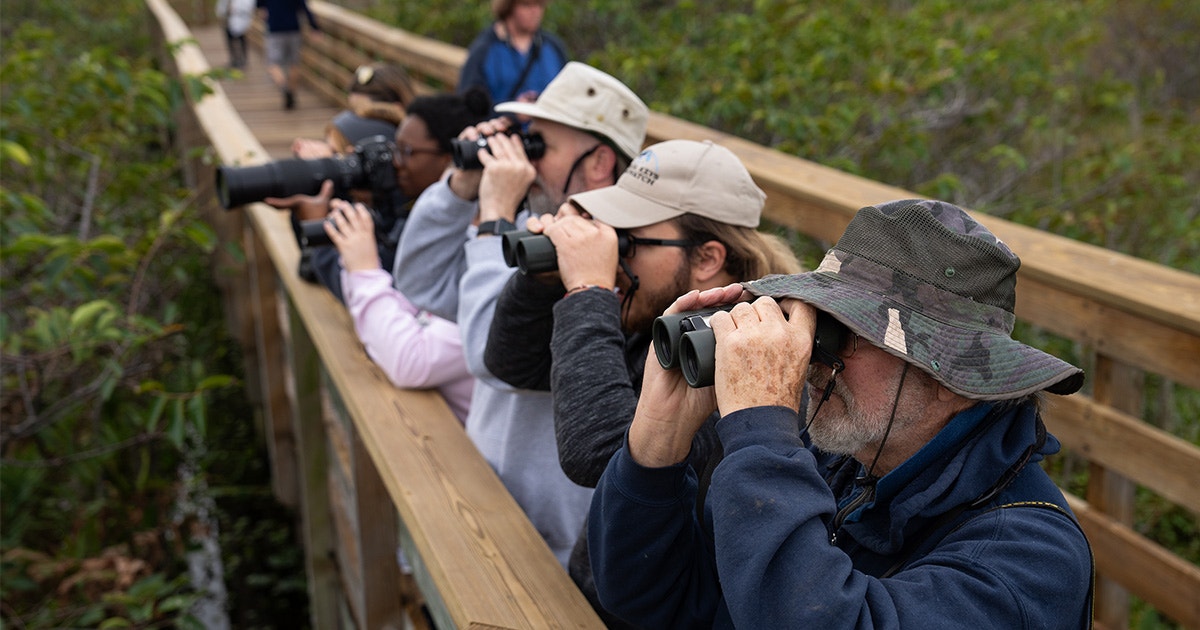It’s hard to stay relevant in the music industry. But one vocalist has done it for decades—crossing genres, keeping up with trends, and collaborating with some of the biggest hitmakers in the field.
We’re talking, of course, about the Common Loon. The red-eyed waterbird is known for giving off a range of eerie cries that echo across wild lakes throughout its breeding range in the northern United States and Canada. “A loon has a pretty dynamic vocal repertoire that’s really uncharacteristic of a non-songbird,” says Jay Mager, a loon researcher at Ohio Northern University.
These calls aren’t just the soundtrack for lakeside summer nights; they’re also a staple for generations of popular music. From Michael Jackson to Nicki Minaj, from ‘80s Eurodance DJs to modern EDM producers, a wide range of musicians have brought on the loon as a featured artist over the years—though they haven’t always given the birds their credit. These days, the species has been back in the spotlight, partnering with Doja Cat on hits like “Attention” and “Get Into It (Yuh).”
(This song from Doja Cat features a classic loon wail in the intro. Scroll on for more videos and a custom Spotify playlist of loon hits,)
So how did the loon get its start in the music business? And why have its mournful cries echoed through popular culture for so long?
To answer that, we have to go back to an earlier era of music production, when synthesizers were starting to transform the way songs were made, says Charlie Harding, songwriter and co-host of the podcast “Switched on Pop.” The 1970s and ‘80s saw the rise of early samplers—keyboards designed so people could record their own sounds and play them back. But if they didn’t want to do that legwork, musicians could also choose from pre-recorded samples offered as keyboard presets or bundled together separately and sold on floppy disks.
Loons flew onto this scene with the 1984 release of a new synthesizer, the aptly named E-mu Emulator II.
As samplers spread, these default sounds started showing up over and over in different songs, sometimes defining entire genres, Harding says. It’s why the same echoey piano sets the stage for scores of ‘80s power ballads, and a dramatic orchestral moment from Stravinsky’s “The Firebird” punctuates countless hip-hop tracks.
Loons flew onto this scene with the 1984 release of a new synthesizer, the aptly named E-mu Emulator II, which would go on to become a bestseller. A preset disk of nature sounds for the keyboard included the loon’s tremolo call, a repeated up-and-down pitch that sounds a bit like a maniacal laugh. Soon enough, that cackle made its way to the dance floor.
As music journalist Philip Sherburne detailed for Pitchfork in 2012, the sample really took off when two European groups looped it into the tracks “Sueño Latino” and “Pacific State,” which became huge dance floor hits. Once people started hearing the call at DJ sets and clubs, the tremolo chuckled its way onto more and more records until it became a signature for the house and electronic scene. “Someone decided that a Stravinsky orchestral hit could be the sound of hip-hop,” Harding says. “Why can’t the loon be the sound of late-night dance music?”
Since then, the loon’s distinctive laugh has reverberated through decades of popular music. In recent years, it’s shown up in a laid-back summer jam from Calvin Harris; an extravagant club banger from Lady Gaga; and a cinematically moody ballad from Lana Del Rey.
(The loon’s tremolo loops throughout this 1989 dance hit.)
It even pops up among the raunchy jungle imagery of “Anaconda” by Nicki Minaj, which Harding says is “an ecological disaster—these biomes should not mix.” In fact, a lot of songs use the loon’s tremolo to conjure up a tropical, far-off vibe, even though the bird spends much of the year in the cooler climates of the northern lakes and the rest wintering along the coasts.
To put another damper on it, the tremolo that’s livened up decades of dance music is actually an alarm call, says Jim Paruk, a loon expert at Saint Joseph’s College of Maine who has spent decades studying the birds. A loon will often let out the sound if it’s feeling threatened, like if a predator is nearby or a human is getting too close to its nest. The more stressed out the bird is, the more repeated “laughs” it will add to the call: “It goes from being alarmed and frightened, to being really frightened, to like, ‘I’m about to lose it,’” Paruk says.
Beyond the tremolo, another of the loon’s signature sounds has also been making its way through the music charts lately after building a long career in film. It’s the wail: the classic, haunting woo-OO-oo that rings out across the bird’s habitat.
(Listen for the loon in the intro and around the 2:52 mark.)
This sound is thought to be a “contact call” between loons when they’re out of sight of each other, Mager explains—like a mate looking for its partner, or a parent trying to locate its chicks. One loon in a pair might use it to call its mate back to the nest when it’s out foraging, Paruk adds. “So essentially, ‘Come here.’ The mate will respond, ‘Here I come,’” he says.
The wail has already been a popular sound effect for decades of movies and TV shows, from Harry Potter to Game of Thrones. It’s often used as a shorthand to evoke a sense of wilderness, or to just give audiences the creeps, says Natasha Bartolotta, stewardship and outreach manager for the National Loon Center in Minnesota. And much like in music, it doesn’t matter if the habitat is all wrong: Movie magic has conjured up loon wails in deserts, jungles, and even outer space. “It’s Hollywood,” Bartolotta says. “They want to set the scene and invoke a particular feeling.”
Much of the wail’s current influence can be traced back to one person: Ari Starace, better known by his producer name, Y2K.
Lately, though, this call has also been popping up in chart-topping hits like Doja Cat’s “Attention,” where it floats in over sweeping strings in the intro, or “go dumb,” where it weaves its way through rapper blackbear’s flow. Much of the wail’s current influence can be traced back to one person: Ari Starace, better known by his producer name, Y2K. The artist—who has worked extensively with Doja Cat, along with other rappers like bbno$ and Yung Gravy—uses the loon’s wail as his beat tag, dropping it into all the songs he produces.
Starace tells Audubon that he doesn’t have any personal history with the birds or memories of hearing them in the wild; he lives in Los Angeles and grew up in Arizona, a far cry from loon territory. But when he found the wail in an online pack of nature samples, it made an instant impression. “I stumbled on the loon call, and I just was immediately very attracted to it,” Starace says. “I think it’s a very tasteful sound.”
Since trying out the call in a few tracks, like a “What Is Love?” remix around nine years ago, Starace says he naturally started using it more until eventually it became his signature sound. He likes that the loon call is distinctive without being distracting: “It’s good in every situation,” he says. “I don’t think it changes the energy of any song you put it in.” Now, whenever he works on a track, he takes the same sound file of the tremolo sample and works it into the mix—so as Starace’s footprint in the music industry has grown, the loon’s wail has been flying high along with him. “If you’re listening to hip-hop today, it’s very likely you might hear loons crying out of cars driving down the highway,” Harding says.
(Y2K drops his loon “beat tag” around 30 seconds in.)
Not all of the loon’s various calls have gotten the same spotlight. Musicians have yet to pick up the bird’s yodel, a complex, long-distance call that’s only made by males. This territorial call contains a lot of valuable information for other loons, Mager says. Individual birds can use it to signal how big and strong they are, and how ready they are to fight for dominance. Another overlooked part of the loon’s vocal repertoire is the hoot, a soft and “kind of a cute sound” that is usually given within the family unit of a mated pair and their chicks, Bartolotta says.
Still, the tremolo and the wail have shown impressive staying power in pop culture—a legacy that’s especially notable in today’s digital age, when music producers have an endless world of sounds at their fingertips. “Even though we have all of these options available to us, we continue to reach back into the sounds that are familiar and known,” Harding says.
Maybe that’s because of the way music works in a post-sampling world: By remixing the same sounds from the past, like that tremolo preset from the early keyboards, artists place themselves in a longer cultural conversation, Harding says. Maybe it’s something about the calls themselves, Paruk speculates: their repeated patterns, their moody chords, the way they sound distinct from anything else in nature.
Or maybe it goes deeper. For Mager, the loon’s call seems to have a unique power to transport us out of our everyday lives and evoke a sense of the unknown—of “what’s still wild out there.” Though that feeling can be scary at first, it can also be a comfort, he says. In our human-centric world, the call of the loon can remind us of our connection with nature and the importance of protecting it.
“Imagine a world without the loon call. Imagine a world that didn’t have the beauty, and the curiosity, and the intrigue that these calls have evoked,” Mager says. “It would be an empty place, at least for me.”




